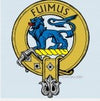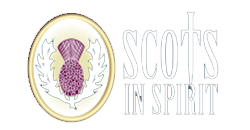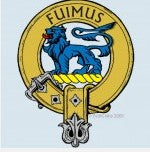
Clan Bruce
Crest: A lion stantan Azure armed and langued Gules

Motto: Fuimus (We have been)
Tartan:

Clan Chief: Andrew Bruce, 11th Earl of Elgin. He is convener of the Standing Council of Scottish Chiefs.
The de Brus/de Bruis name is from Normandy’s Brix area, and the family has both Scottish and English branches. Family members came with William the Conqueror in 1066 and received the lands of Skelton in Yorkshire. In 1106 Robert de Brus came to England and became a companion-in-arms of Prince David (later David I of Scotland); in 1124 David declared Robert first Lord of Annandale. William the Lion (King of the Scots 1165-1214) confirmed this grant of the lands of Annandale to his son (also Robert).
Clan Bruce was Ruling House of the Kingdom of Scotland 1306–1371. The foundation for their royal claim started in 1219 when Robert Bruce, 4th Lord of Annandale married Isobel of Huntingdon, a niece of William the Lion. Their son Robert Bruce, 5th Lord of Annandale, claimed succession on the death of Alexander III of Scotland in 1286, as did John Balliol; but Margaret, Alexander's infant granddaughter was named as heir. She died in 1290 travelling to Scotland to claim the throne; the Guardians of Scotland, fearing civil war between Bruce and Balliol, asked Edward I of England to arbitrate. Edward insisted the contenders first recognise him Lord Paramount of Scotland so when he chose Balliol in 1292, Balliol swore allegiance to him. Balliol later rebelled but was defeated and forced to abdicate after the Battle of Dunbar in 1296.
William Wallace now led the fight for independence, with no Scottish monarch, infighting between different claimants, and shifting allegiances such as that caused by John Balliol’s seizing and granting Annandale to the Comyns in 1295. After Balliol’s abdication, the Bruces regained Annandale and Carrick; in early 1296, Robert the Bruce married his first wife, Isabella of Mar. Both Robert the Bruce and his father swore allegiance to Edward at Berwick in August 1296. However, when the Scottish revolt against Edward I broke out in July 1297,owever, when the 22 year old future king joined it, but later made terms with Edward in a treaty known as the Capitulation of Irvine. When Edward returned to England after winning the Battle of Falkirk in 1298, Bruce was allowed to keep his Annandale and Carrick lands. He and John Comyn succeeded William Wallace as Guardians of Scotland, but were rivals for the throne; this ended in a meeting at Greyfriars Church in Dumfries in February 1306, where they came to blows and Bruce stabbed Comyn through the heart. Although excommunicated by Pope Clement V, he was crowned at Scone 6 weeks later, re-establishing an independent Scotland. In 1314 he led the Scottish army at the Battle of Bannockburn where the English under Edward II were defeated.
Robert the Bruce died on 7 June 1329; his son became David II of Scotland. In 1346 under the terms of the Auld Alliance, David marched into England in the interests of France, but was defeated at the Battle of Neville's Cross and imprisoned on 17 October. He returned to Scotland 11 years later after negotiation of a treaty and ruled until he died in 1371 without issue; the line of succession passed to the House of Stewart.
The family of course continued; Sir Edward Bruce was made commendator of Kinloss Abbey, appointed a judge in 1597 and appointed a Lord of Parliament (as Lord Kinloss) in 1601. Edward Bruce went with James VI to claim his English throne in 1603, was subsequently appointed to English judicial office as Master of the Rolls and granted a barony as Lord Bruce of Kinloss in 1608. In 1633 his son, Thomas, was created first Earl of Elgin. When the fourth Earl died without issue, the title passed to the descendants of Sir George Bruce of Carnock, who already held the title Earl of Kincardine and in 1747 the Earldoms were united.
Thomas Bruce, 7th Earl of Elgin was a diplomat and ambassador to the Ottoman Empire between 1799 and 1803. He spent much of his fortune rescuing marble sculptures from the Parthenon in Athens, which were falling into ruin - now known as the Elgin Marbles. His son James, 8th Earl of Elgin and 12th Earl of Kincardine, was Governor General of the Province of Canada (1847–1854) and Viceroy of India (1862–1863).
For more details of Clan Bruce and its history, order one of our Clan Books.






